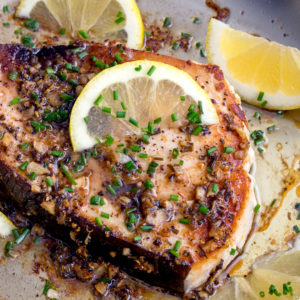Swordfish
QUICK FACTS
Taste: Swordfish has mild and sweet flavoured. It has a rich meaty texture and does not smell fishy. It has pinkish-orange flesh when raw, which turns beige once cooked.
Nutrition Value: Protein, Omega 3, Fibre, Sodium, Potassium
Ways to cook: Pan Seared, Grilled, Baked, Fried, Braaied
Recommended Portion Sizes per person: 250 – 300g
Similarities: Fresh Tuna, Marlin
Sides Suggestions:
- Grilled Swordfish & Eggplant Salad & Honey & Thyme Vinaigrette
- Swordfish Niçoise & Provençal Rosé
- Pan Fried Swordfish with a Turmeric & Ginger Sauce
- Sicilian Swordfish (Pesce spada alla Siciliana)
- Grilled Swordfish Salmoriglio
- Pan Roasted Swordfish with Cherry Tomato & Capers
- To Drink with Swordfish: Pinot Noir, Chardonnay, Sauvignon Blanc, Merlot, Zinfandel, Sangiovese, Dry Rose
Best way to cook
Pan-frying: You can choose to fry your fish as is or cover it in flour or breadcrumbs. Using the extra coating will give your fish more texture and body. If you’re going to dip it in flour, soak the fish in a bowl of milk for 3 to 5 minutes, before covering it in flour or breadcrumbs. This will help the coating stick to the fish.
Get your pan ready for frying by pouring a few tablespoons of vegetable oil into it. You can also use clarified butter which will taste great on the fish. Heat the pan until the oil slides around easily. You can splatter a few drops of water in the pan – if the water sizzles, it’s ready for your fish. Place the fish flesh side down in the pan – the side you’ll be presenting to your diner (the non-skin side).
Once your fish is in the pan, slide a spatula gently underneath to prevent it from sticking. Cook the fish for 3 to 4 minutes on one side and then flip it. Fish usually cooks for 10 minutes per inch of thickness. Use a wide spatula to prevent breaking the fish. Cook for another 3-4 minutes or until the flesh turns pearly white and flakes easily with a fork. Carefully lift it out of the pan and serve immediately.
Oven baking: Baking fish in the oven enables you to control the cooking temperature and limit how much you handle the fish, preventing it from overcooking or falling apart.
Season fillets with pepper, dip in egg and coat in bread crumbs. Preheat the oven to 275°C and line a baking tray (glass or metal) with aluminium foil. Brush with olive oil.
Arrange the individual fish fillets on the baking tray in a single layer. Don’t allow the fish fillets to overlap one another. Bake in the pre-heated oven for 15 to 25 minutes or until the fish flakes easily, basting frequently with butter
Braaing: The first thing to know about braaing a fish is to properly oil the grid and both sides of your fish. Braai your fish skin down at first before turning to cook the other side. For seasoning, you can use some salt and pepper with melted butter mixed with lemon juice or a little garlic or chili.
If you’re braaing a whole fish, place the whole-fish skin side down in foil and wrap the parcel to lock in the steam. You can open it now and then and base it with a marinade as you would in the oven.
Fish fillets are quicker to braai. Five minutes a side is a good rule of thumb, but the cooking time will depend on the thickness of the fish. It is done when it flakes easily when prodded with a fork.





